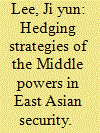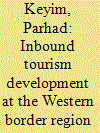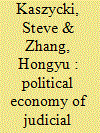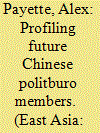|
|
|
Sort Order |
|
|
|
Items / Page
|
|
|
|
|
|
|
| Srl | Item |
| 1 |
ID:
152343


|
|
|
|
|
| Summary/Abstract |
Many middle powers in East Asia—particularly South Korea and Malaysia—are affected by the strategic relationship between the USA (hereafter the USA) and China. Therefore, I would like to examine the strategic behaviors of the middle powers in East Asia from a hedging strategy perspective. The hedging strategy extends the logic of the traditional balance of power theory while maintaining a strong emphasis on structural incentives, which critics have found lacking in the soft balance approach. Most East Asian states have calibrated their security measures and strategies in response to the changing US-China relationship. The purpose of this article is to compare the hedging strategies of South Korea and Malaysia, which are middle powers, that affect the East Asian security order. This article, thus, aims not simply to explain specific instances of the hedging strategies of middle powers but also, based on this theoretical foundation, to establish a new frame of analysis for the hedging strategies of middle powers through objective and critical assessment.
|
|
|
|
|
|
|
|
|
|
|
|
|
|
|
|
| 2 |
ID:
152344


|
|
|
|
|
| Summary/Abstract |
During the last 5 years, Russia and Japan have been able to widen and deepen bilateral ties in many spheres, including politics, economics, and culture. At the same time, the further qualitative improvement of bilateral relations is hampered by strong influence of an enduring negative historic memory of Japanese society toward Russia mostly due to the so-called Northern Territories syndrome. The formation of Russia’s image in Japan is also strongly influenced by a number of time-limited factors, such as the state leader’s popularity, single-moment events, empiric experience, and others (Streltsov 43). In this paper, the author traces the recent history of the territorial dispute between two countries and then attempts to evaluate the influence exerted by four time-limited factors: the triple disaster in Japan (as an example of the implications of natural disasters), the two leaders’ political aspirations, mutual trust, and popularity at home (as related to the personal features of President Putin and Prime Minister Abe), on the two countries’ approach toward signing a peace treaty and solving the territorial dispute. According to the author’s hypothesis, the strategic vision of Putin and Abe and their trustworthy relationship are playing the key role in improving ties between the two countries. Moreover, due to its importance for these ties, this paper considers the geopolitical environment of the Russo–Japan relations and the current state and perspective for bilateral energy cooperation. Finally, the author turns to an evaluation of whether a long-overdue compromise on the territorial dispute could be reached anytime soon.
|
|
|
|
|
|
|
|
|
|
|
|
|
|
|
|
| 3 |
ID:
152346


|
|
|
|
|
| Summary/Abstract |
Based on literature review and statistics of National Tourism Administration of China and Xinjiang Uyghur Autonomous Region (XUAR) Tourism Bureau, this article examines the trends of inbound tourism development in the region. The results show that the inbound tourists in the XUAR are only a tiny portion of the Chinese, and the regional total which mainly is made up of domestic tourism originated from the coastal areas. Among the Central Asian countries, Kazakhstan has become the largest inbound tourism market of the XUAR. The article further suggests that it is worth to investigate whether the inbound tourism development of the region is affected by the geopolitical and geo-economic situations and the national strategic interests of respective neighboring countries.
|
|
|
|
|
|
|
|
|
|
|
|
|
|
|
|
| 4 |
ID:
152345


|
|
|
|
|
| Summary/Abstract |
Like other developing countries, China has been struggling with corruption. Judicial corruption, in particular, damages the rule of law and presents a market disruption as an outcome of a lack of commitment by the government regarding property rights. This article seeks to explain the variations in judicial corruption within China, and it develops a theory of city-level corruption of judges. The theory is tested by an empirical study with data from the World Bank corruption survey using a Bayesian spatial linear model. While wealth appears to diminish corruption, there is also a strong spatial relationship with regard to the level of judicial corruption in China, indicating that as some regions become less corrupt, surrounding areas also experience a diminution in corruption. Thus, through a process organic to the current regime, China could experience an increase in judicial trustworthiness.
|
|
|
|
|
|
|
|
|
|
|
|
|
|
|
|
| 5 |
ID:
152342


|
|
|
|
|
| Summary/Abstract |
Efforts at finding the next Politburo members have, since the mid-1970s, been at the center of Chinese Elite and leadership studies. From the late 1980s onwards, leadership selection has become more institutionalized. This allows scholars to narrow down their search to more “propitious” elements in order to try to predict who might ascend to the Politburo. Consequently, this article ponders if it was possible to differentiate these individuals from their less “promotable” counterparts upon their entry into the Central Committee between 1992 and 2012. Based on statistical reassessment of variables commonly found in the literature, the article argues that soon-to-be Politburo members were already displaying a different profile than that of their counterparts 5 to 10 years before their entry into the Politburo. This article does not seek to establish a perfect predictive model rather than circumscribe the profile-type and environment in which these rising Elites can be found. Lastly, the latter opens a discussion on what to expect from the results as well as competing profiles found inside the Central Committee.
|
|
|
|
|
|
|
|
|
|
|
|
|
|
|
|
|
|
|
|
|